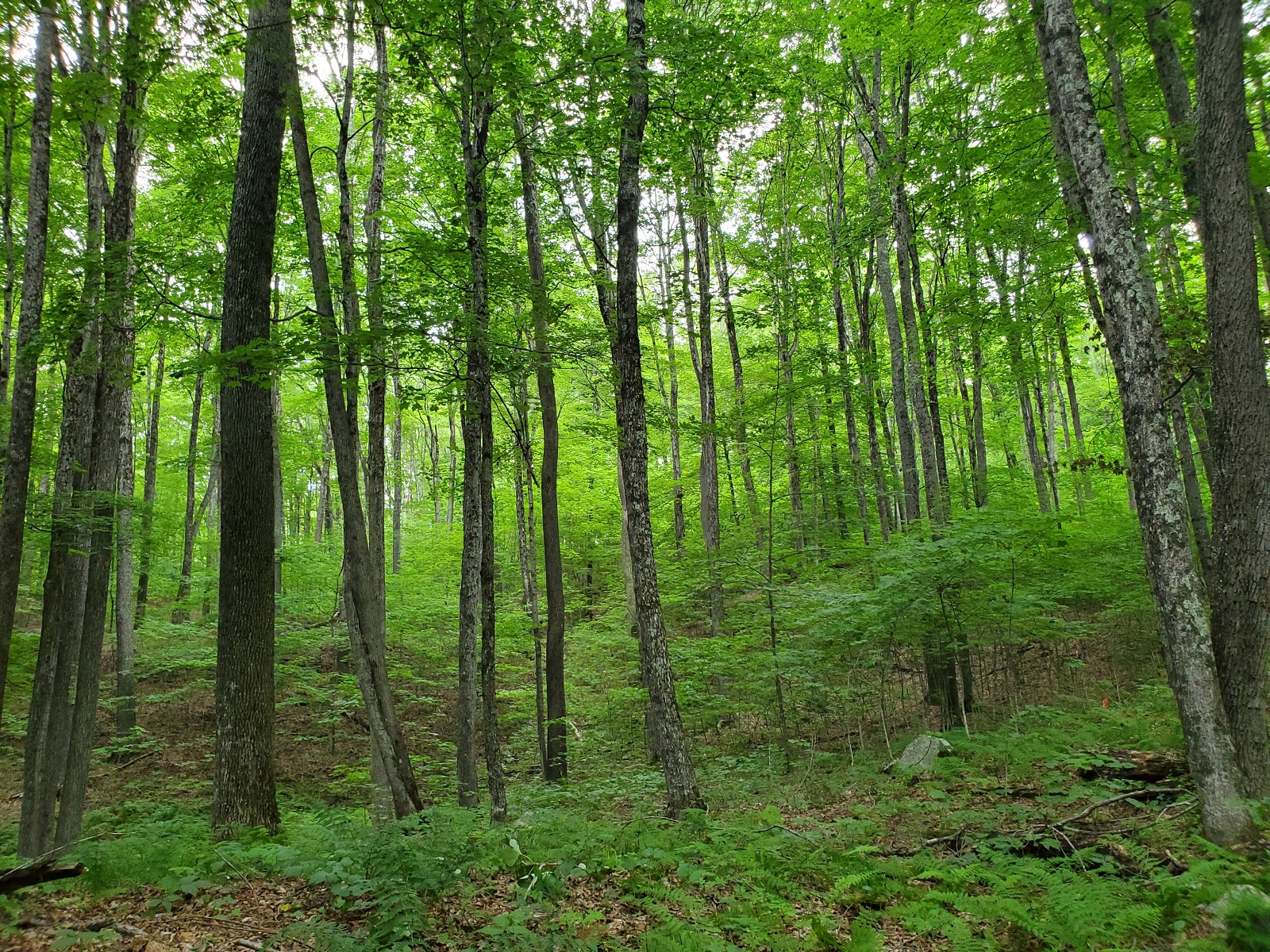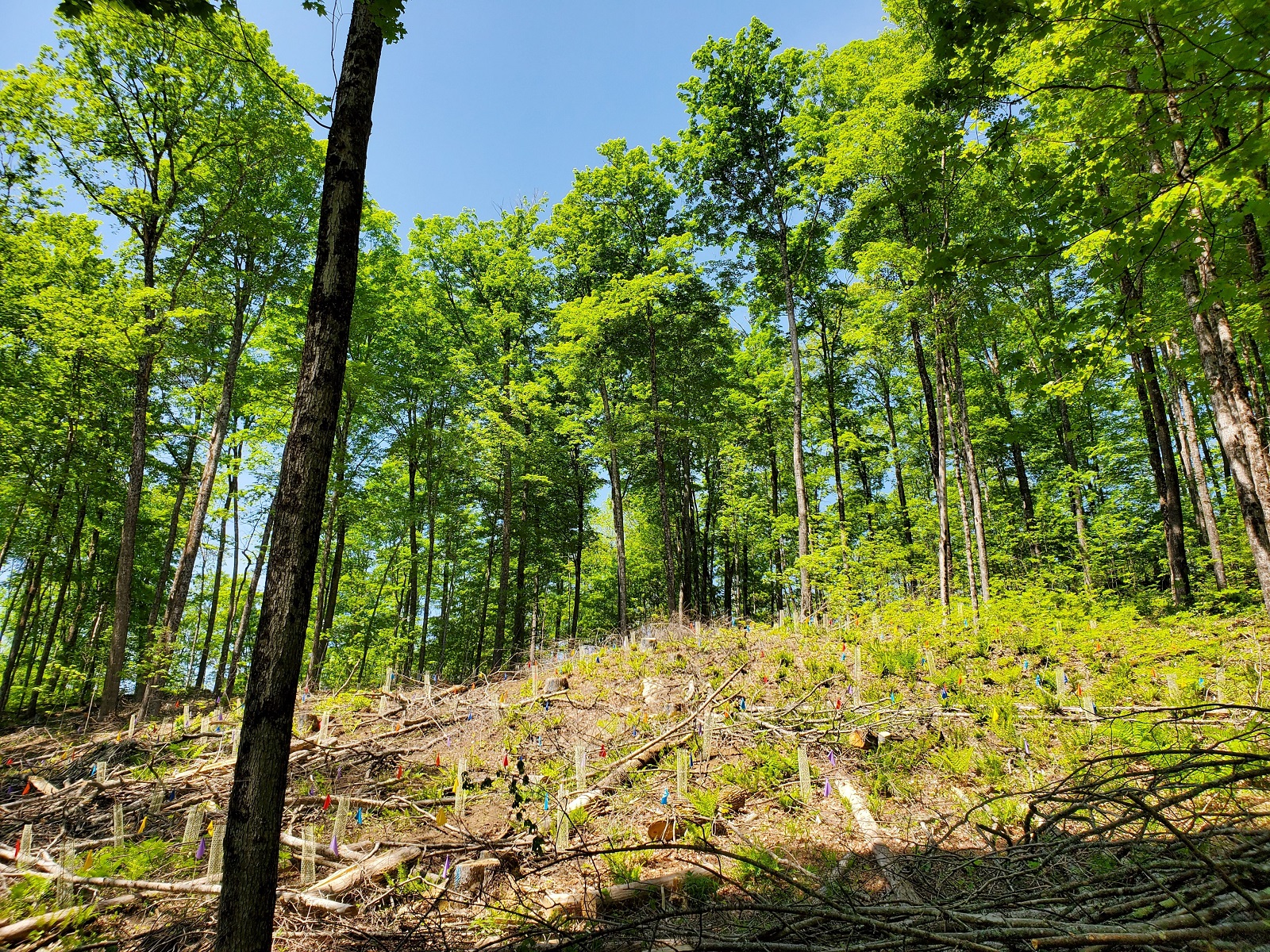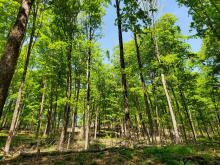Secondary tabs
Submission information
| Study Title | Adaptive Silviculture for Emerald Ash Borer (Corinth, Vermont) |
|---|---|
| Case Study Type | Forest type, Forest health, Management type |
| Management Subcategory | forest adaptation, carbon, managing invasives, wildlife habitat |
| Site Photo |
|
| Image caption | Crop-tree release in matrix between group openings at Corinth site |
| Lay Summary | Test co-produced adaptive silvicultural systems for increasing the resilience of rich northern hardwood forests to the impacts of emerald ash borer invasion and climate change. |
| Location | Corinth, Vermont |
| Location Description | Clements Woodlot |
| Cover Type | Northern Hardwoods |
| Natural Community Classification | Rich Northern Hardwood Forest |
| Plant Community/Habitat Class Growth Stage | Understory reinitiation |
| Primary Forest Health Threat | emerald ash borer |
| Secondary Forest Health Threats | deer, drought, emerald ash borer |
| Primary Pests/Disease | emerald ash borer |
| Soils | Sandy and silt loams (Cabot, Colrain, Pomfret, Turnbridge-Woodstock) |
| Start date | Tue, 01/01/2019 - 00:00 |
| End date | Sun, 01/01/2023 - 00:00 |
| Stand History | Twelve, 15-acre treatment units compose the study area (with one demonstration unit). The stand is overstocked for this forest type with an average basal area of 132 ft2/ac and 270 trees per acre. Deadwood amounts are relatively consistent across all treatment groups. The stand contains above average deadwood amounts for this forest type with approximately 13 snags per acre and 387 ft3/ac coarse woody material. Invasive earthworms are present throughout the site with 64% percent of all plots reporting some evidence of worms. Like other rich northern hardwood forest types, this site has high herbaceous diversity with 46 different genera of herbaceous flowering plants identified and 21 fern found species across all of the plots. Trilliums (Trillium), bellworts (Uvularia) and toothworts (Cardimine) are common. Several rich site indicators like blue cohosh (Caulophyllum thalictroides), showy orchid (Galearis spectabilis), maidenhair fern (Adiantum pedatum) and silvery glade fern (Deparia acrostichoides) can be found. Earthworm presence has made conditions more favorable for grass and sedge species and several invasives are present including hemp nettle (Galeopsis bifida) and garlic mustard (Alliaria petiolata). The pre-harvest inventory began in June when many spring ephemerals had already passed peak so this inventory likely failed to capture the true diversity of the herbaceous community. |
| Pre-Treatment Species Composition | The stand is predominantly composed of rich northern hardwoods, dominated by sugar maple and white ash with components of American beech, yellow birch, red maple, American basswood, ironwood and other species. White ash represents approximately 39% of the overall basal area. While sugar maple dominates regeneration classes, the regenerating layer is relatively diverse with 35 woody species found across all plots. White ash represents almost 6% of total regeneration. |
| Species 1 | Fraxinus americana (white ash) |
| Species 1 Percent(%) | 50% |
| Species 2 | Acer saccharum (sugar maple) |
| Species 2 Percent(%) | 43% |
| Species 3 | Betula alleghaniensis (yellow birch) |
| Species 3 Percent(%) | 9% |
| Case Overview | Test adaptation strategies for increasing resilience of rich northern hardwood forests with a significant white ash to emerald ash borer invasion and climate change. |
| Silviculture Objectives | To create and maintain compositional and structural complexity, allowing for multiple pathways to recovery following an anticipated EAB invasion and expected loss of ash. In this uneven aged forest, white ash will ideally remain present in all size classes, yet future adapted species that are currently present or projected to have suitable future habitat will be encouraged. A diversity of microhabitat conditions will be maintained, and understory vascular plant communities enhanced. Increased amounts of snags (1-4/acre) and cavity trees along with greater downed dead wood volume (>300 ft3/acre) will preserve structural complexity, wildlife habitat and carbon pools. Forests managed with these objectives will be compared with those managed with an exploitative approach (singular focus on removing merchantable ash) and unharvested controls. |
| Landowner Objectives | Establish large-scale, long-term silvicultural experiment for testing adaptation strategies for increasing resilience of rich northern hardwood forests with a significant white ash to emerald ash borer invasion and climate change. |
| Silviculture Prescription | Exploitative Treatment: Removal of all mature ash Resilience Treatment: A group selection approach that converts 20% of the area to gaps (0.1-0.25 acres). These gaps will be strategically placed in areas with advance regeneration or below economically mature trees, including ash. In these gaps, bare-root seedlings of future adapted northern hardwoods currently found on site in low abundance (northern red oak, black cherry and American basswood) and several northern hardwood species expected to gain suitable habitat into the future (bitternut hickory, black birch and American chestnut) will be planted. Crop-tree release will thin the remaining matrix to maintain 70-80 ft2/ac BA with trees marked for quality, longevity, female ash, and resistant crown forms. All basswood on site will be preserved and 4 large ash (>14 in DBH) per acre will be preserved to recruit snags and downed wood. Slash will be retained on site to minimize herbivory and erosion and all existing cavity trees will be reserved. Control: No harvest or other treatments, allowing for natural succession, including ultimate EAB invasion, to take place without management. These stands serve as a reference condition to the other harvested treatments. |
| Regeneration Method | selection |
| Factors Influencing Prescription Choice |
|
| Climate Adaptation Considerations | Several tree species were selected for planting based on input from local managers and ecologists and guided by regional projections for changing suitable habitat under climate change. All planted species represent examples of assisted population expansion given focus on increasing representation of species already present at low levels in this ecosystem, but expected to be favored by future climate regimes. |
| Equipment used | Hand felling and cable skidding (with small dozer) |
| Prescription Notes | What Actually Happened During the Treatment Summer 2020: Plots established, pre-treatment inventory of overstory, regeneration layers, deadwood, and plant community. Soil moisture measured and soil sampled from each plot for carbon analysis. Bird audio recorders set up and soil sensors constructed in control blocks. Hyperspectral ground truth data taken by GatorEye. Winter 2020/2021: Treatments applied according to prescription. Spring 2021 (Planting): Seedlings were planted in eight of the resilience treatment quarter acre gaps (228 seedlings per plot, 38 replicates per species). Spacing was 2 m2 and seedlings were randomly designated, with equal proportions in each gap. Species: American basswood, American chestnut, bitternut hickory, black birch, black cherry, northern red oak Summer 2021: First post-harvest plot inventory. All overstory trees, regeneration layers, deadwood, and plant community re-inventoried. |
| Post-Treatment Assessment Done | yes |
| Post-Treatment Assessment Expected | yes |
| Post-Treatment Assessment | No data yet. |
| Future Treatment Plans | Success of the first treatment will need to be reassessed following the EAB invasion before planning for future harvests. Cutting cycle length will be 20 years. |
| Keyword(s) | rich northern hardwoods, Adaptive Silviculture for EAB, Corinth, INSPIRES, Dartmouth College Woodlands |
| Data Available? | no |
| Basal Area Pre-Harvest | 132 |
| Basal Area Units |
|
| Primary Contact | Tony D'Amato |
| Contact Title | Professor and Director, Forestry Program |
| Contact Organization | University of Vermont, Rubenstein School of Environment and Natural Resources |
| Contact Email | awdamato@uvm.edu |
| Additional Photo 1 |

|
| Caption 1 | Corinth 2020 Pre-Treatment |
| Additional Photo 2 |

|
| Caption 2 | Corinth 2021 Planted Gap |
